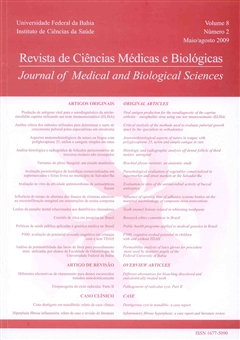Parasitological evaluation of vegetables comercialized in supermarket and street markets at the Salvador/Ba
DOI:
https://doi.org/10.9771/cmbio.v8i2.4064Keywords:
Vegetables- Contamination – Enteroparasites.Abstract
Studies has been sugested the occurrence possibility of endoparasite transmission to the man througth the crude fruits and vegetables provenient from cultivated areas contaminated by animal and men fecal dejections. Searching to verify the prevalence of vegetable parasites forms, we investigated crespa alfaces (Lactuca sativa) and agrião (Nasturdium officinale) samples, 30 of each one, from supermarkets and street markets at the Salvador/Ba. The samples were weighed and divided in equal parts, one of them washed in distilated water and the other with sodium hypochlorite solution. The washes content was left for 24 hours in sedimentation to further analyses. The samples showed 95% of contamination, 100% provenient of streets markets and 90% from supermarkets. In the material we found: Entamoeba, Endolimax sp and Giardia sp cysts, non esporulated oocysts, ancilostomidae, Ascaris and Trichuris sp eggs, nematodes larvae and Acari. With the results, we found that vegetables are important in the enteroparasite transmission, and suggested that a good hygienization of them is crucial to the “in natura” consumption. We conclude that these two varieties, commercialized presented considerable contamination indices, indicating that the culture and manufactured procedures must be reviewed.Downloads
Download data is not yet available.
Downloads
Published
2009-06-02
How to Cite
Santos, N. M., Sales, E. M., Santos, A. B. dos, Damasceno, K. A., & Thé, T. S. (2009). Parasitological evaluation of vegetables comercialized in supermarket and street markets at the Salvador/Ba. Journal of Medical and Biological Sciences, 8(2), 146–152. https://doi.org/10.9771/cmbio.v8i2.4064
Issue
Section
ORIGINAL ARTICLES
License
The Journal of Medical and Biological Sciences reserves all copyrights of published works, including translations, allowing, however, their subsequent reproduction as transcription, with proper citation of source, through the Creative Commons license. The periodical has free and free access.


